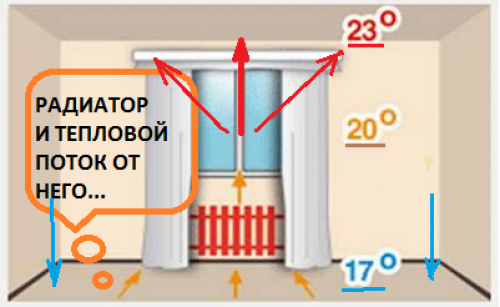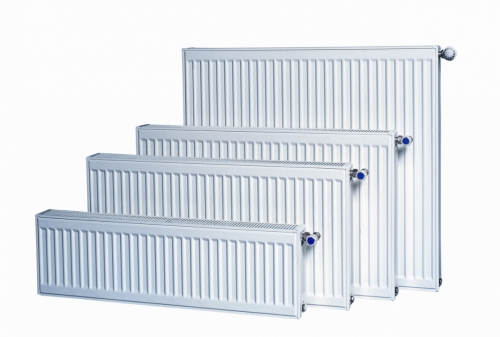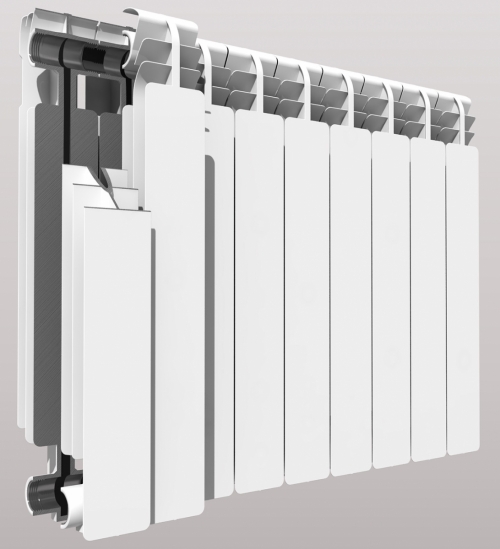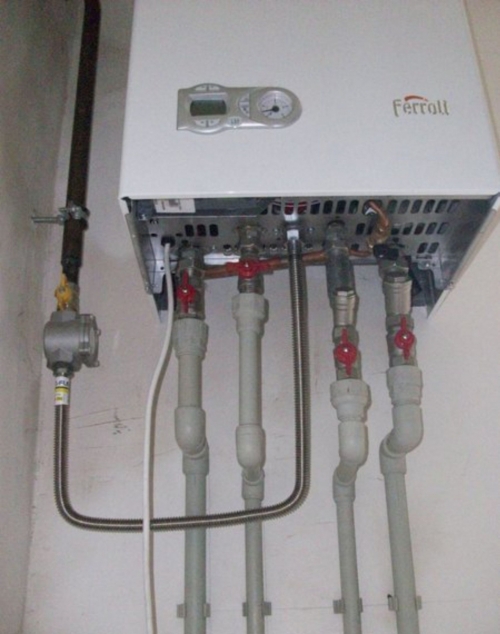The arrangement of a warm floor allows you to save well on heating. In addition, he ...
|
|
In the process of building the foundation, several stages are distinguished, one of which is ... |
Warm floor in the kitchen is a modern level of comfort, turning the usual ... |
DIY heating

It is pointless to prove that for a comfortable year -round living in the cottage, it is necessary to equip heating. Everyone understands this. Many are interested in specific applied issues which heating system to choose, what are the features of its arrangement and installation, and whether to do everything yourself. All this really can focus, not so much because of complexity, but because of the variety. The good old stove heating sunk into oblivion, today the market can offer a lot of innovative and economical, comfortable and maintenance of solutions. Therefore, in the framework of this article, we will talk about how to equip the heating of the cottage, what heating wiring schemes exist, how to choose radiators and pipes for heating. We will also touch on applied questions: how to make a heating project and calculate everything how to carry out the installation of the system with your own hands and what are the nuances.
- Cottage heating systems what to choose
- Cottage heating system
- Which radiators for heating to choose
- How to choose a heating boiler
- What pipes for heating to choose
- DIY heating
Cottage heating systems what to choose
There are several gradations according to which heating systems differ. Let's start with the main type of coolant, which is giving heat, heats the room.
Heating coolant in heating systems
By the type of coolant of the heating system, cottages are divided into water, electric, air and open fire. The latter are a stove, rude or fireplace, they can successfully heat a small one -story house, but the heat will spread unevenly: it will be hot directly near the fireplace, and it will be cold at removal, the floor will also be cold.
Water system The most common, more than 90% of heating cases are implemented precisely with the help of it. It is a closed circuit in which there is a boiler, heating water, pipes and radiators along which water, circulation pump, expansion tank or other concomitant elements heated in the boiler moves. Hot water moves from the boiler through the pipes and radiators, and then, cooling into them, again returns to the boiler, where it heats up, and the cycle is repeated again and again.
Water heating can be implemented using various heating devices. It can be a gas, electric, solid fuel boiler, diesel, as well as alternative energy sources (windmills, etc.). And instead of water in the system, there may be antifreeze. Installation of such a heating system with all equipment and design work will cost about 9,000,100,000 cu.
Electric system It can be represented by electric convectors, infrared long -wave heaters (ceiling) and a warm floor system. Its installation is very simple, you just need to buy heaters and install them in the right places. Thanks to this, the price is the lowest price for the arrangement of electric heating, about 1200,1500 cu. for the purchase and installation of equipment. But at the same time, monthly electricity accounts will be astronomical. In other words, such heating is difficult to name economical.
Air system The heating of the cottage is based on hot air circulation. The system has a heat generator that heats the air, air ducts along which heated air moves and returns to the heat generator cold. Heated air through the air ducts rises into a heated room and goes under the ceiling in such a place to displace the cold air, which accumulated next to the door or window. Cold air is supplanted into other air ducts leading back to the heat generator. Air circulation can be implemented in two ways: gravitational circulation due to the difference in temperature and forced ventilation using a special fan. The first method has one significant drawback: if the doors or windows are open, the circulation is disturbed.
The heat generator for the air heating system can burn natural gas, diesel or kerosene, combustion products go to the chimney. It is possible to equip such a cottage heating system only at the stage of its construction, since the project itself should be laid out structural elements and the height of the room for the convenience of the location of the ducts should be increased. This will cost about 11,000 cu.
Conclusion! The most thorough, economically profitable, familiar and convenient is the water heating system. Almost everyone choose it. Electric heating devices can only be considered as additional elements of the cottage heating system, so to speak, a spare version. Air heating has not yet gained mass, although if you lay it in the project, it can turn out much better than a water.
Energy/fuel for a heating boiler
The second gradation, which is important when choosing a heating system, is a type of combustible (or consumed) fuel/energy carrier. The cost of heating the cottage per month will directly depend on the selected energy carrier.
There are boilers on natural gas, electricity, solid fuel and diesel. The last option is extremely rare. Heating with an electric boiler is used as an addition and a reserve option for a gas or solid fuel boiler, especially in regions where electricity is cheaper at night. Solid fuel boilers are used in areas where there is no trunk natural gas. In addition to boilers in which coal or firewood loads, there are modern solid fuel boilers, such as Ferolli operating on pallets.
Important! The most economical and convenient is gas heating (until the gas has risen) and its combinations: gas+electric or gas+solid fuel. In a area where the gas line is completely absent, it is more advisable to put a combined system of a solid fuel boiler + electric.
Way of implementing a heating system with liquid coolant
Since the most common and public is the water system of heating, we will consider how to make heating in the cottage with an example.
Radiators under the windowsThe usual way of arranging heating. It has good heat transfer, but the radiators themselves are sensitive to the coolant. Although for a cottage with autonomous heating this is not essential. In the radiator system, heat rises from the radiator up to the ceiling, reducing the penetration of cold air through the windows, then passes under the ceiling and drops along the walls to the floor, gradually cooling. On the floor, the air returns to the wall with the radiator, where it heats up again.
Water warm floor A system that allows you to make the most comfortable temperature near the floor. Especially relevant for families in which small children. The pipes of the water floor are laid out throughout the area of \u200b\u200bthe room and are embedded in a screed or into the raft. The water circulating through the pipes heats the floor screed, next to it the air is the warmest, then it rises up. Warm floor cannot be used as the only heating system in a cottage with year -round living, since our winters do not allow such luxury. It can only be mounted in addition to radiator.
Substate heating systemi absorbed the best from the radiator and the warm floor system. The pipes are located along all walls around the entire perimeter of the room below, where the skirting board. Heat spreads evenly: both to the floor and to the walls. The room warms up at all points approximately the same. The advantage of such a system is that the place does not engage in radiators and can more organically arrange furniture.
As a result, it should be noted that radiator and skirting heating can be arranged both in the new cottage and in the already built. But the system of warm floor is mounted only at the construction stage, otherwise you will have to completely redo the floor.
Cottage heating system
After choosing the type of heating system, it is necessary to decide on its scheme. We have chosen a water heating system implemented using radiators under the windows, the most common case.
There are 3 different schemes according to which the pipes of the heating system can be carried out: one -pipe, two -pipe and collector.
One -pipe heating scheme It is a closed circuit in which water passes through pipes and radiators one after another as a chain and only, leaving the latter in the radiator system, returns back to the boiler. It turns out in the most low temperature from the boiler the temperature is the lowest. As a result, uneven warming up of the cottage. Such a system is mounted only in small houses and cottages, where the water in the heating system does not have time to cool much.
Two -pipe heating scheme The cottage is more advanced. All radiators are connected to the pipeline with hot water in parallel. Two pipes are suitable for each radiator: through one, hot water enters it from the boiler, and the cooled one goes through the second. There are losses in such a system, but not as large as in one -pipe. The last radiator in the system will be colder, but not much.
Collector systemIdeal for large cottages and houses. In it, hot water from the boiler first enters the collector, which then distributes it to each radiator separately. Similarly, from each radiator it departs one pipe with a return. The collector heating scheme allows you to adjust the temperature in each individual room and even on each individual radiator. Heating occurs evenly. The only drawback is a large number of pipes that somehow need to be diluted around the house. Most often, the collector system is performed in houses under construction: it is convenient to hide the pipes in the floor screed.
Which radiators for heating to choose
The correct choice of heating radiators is no less important than the choice of a boiler. Moreover, the material of manufacturing the radiator will affect its characteristics, durability and may impose certain restrictions on the composition of the water in the system and pipe material. The sizes and shape are also important, but it is rather a matter of convenience and aesthetics, since the main parameters: material, size, power.
Heating radiators from various materials
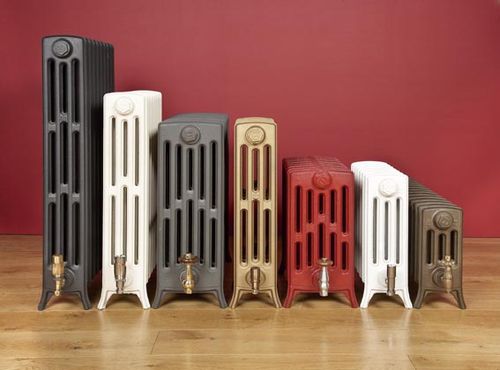
Cast iron radiators The oldest type of heating. They are not afraid of corrosion, high pressure (withstand 9 15 atmospheres), high acidity of water. The room is warmed evenly. But at the same time they have a large weight and some difficulties in installing the pipeline. After several years of oblivion and complete failure, cast -iron radiators are gaining popularity again. This is due to the fact that modern radiators are much smaller in size and beautifully decorated so that they do not violate the overall interior design.
Aluminum radiators At the moment, they buy most often. They have a small weight, low price, a beautiful design and high heat transfer, withstand a high pressure of 10 16 atmospheres. But at the same time, aluminum is very sensitive to the composition and acid-base balance of the water, it should have at least 7 8 pH. Also, in aluminum radiators, it is necessary to remove air from the upper manifold, their weakest place threaded joints. However, they are considered quite reliable.
Steel radiators Heated very quickly and give heat, i.e. They have high heat transfer. The room is heated comfortably with the maximum efficiency. The price of each kW of the generated heat has the lowest price compared to other types of radiators. For example, in the West, steel radiators are a mass solution.
Bimetallic radiators They combine the advantages of aluminum and steel radiators, as they are an aluminum radiator in which the system of steel pipes is mounted, through which water circulates. As a result, the radiators turned out to be strong, durable, withstand a very high pressure of 20 40 atmospheres, are not afraid of aggressive liquids. But in the heating system of the cottage, it is impractical to use them.
The choice of heating radiators depends on the personal preferences of the hosts, most importantly, pay attention to their power.
The power of heating radiators
An important parameter for choosing a heating radiator power is indicated on the product itself and in the passport. It is marked something like this: 1700 W 70/50. We decipher. This means that if the water into the radiator enters with a temperature of 70 s, then passing along the radiator and cooling up to 50 s, 1.7 kW of energy is released.
But more often, manufacturers indicate power for another temperature range of 90/70, which are extremely rare. Therefore, it is necessary to reduce the indicated power by 30%. Then you get an approximate return at the temperatures of the coolant 70/50. It is better to choose a radiator of greater power with a margin than less.
When buying radiators, it matters the size, since they are installed under the windowsill due to the calculation that at least 10 cm is free and from the floor of 15 cm above it (to the windowsill). Otherwise, normal air circulation will not be carried out. The size is usually indicated as follows: 500x1500. This means that the product is 1.5 m in length and 50 cm in height.
Places for connection within radiators can also be located either at the bottom or above. What is necessary in one case or another depends on the project and the pipes of pipes.
When choosing a radiator, it is also necessary to take into account the specifics of the room, the thickness and location of the walls, the number of windows and doors. The power and size of the radiator that are calculated in the heating project directly depend on these indicators.
How to choose a heating boiler

Distinguish gas, electric, solid fuel and diesel boilers. You need to choose the one that the energy carrier to which is the most affordable in your region and the cheapest.
In addition, it should be borne in mind that for living boilers on gas, diesel fuel and electricity, operating in automatic mode, i.e. They do not require constant intervention from the outside. Service maintenance of such boilers is carried out once a year, after the end of the heating season. And in a solid fuel boiler, it is necessary to constantly load fuel (pallets). Despite the fact that there are combined boilers on two types of fuel, it is better to choose the type of boiler that works only on one coolant, it is more reliable.
Heating boilers are single -circuit and double -circuit. Single -circuit Provide only heating or only heating of hot water for household needs. Double -circuitthey can perform both functions at the same time. In cottages, either a double -circuit boiler or two single -circuit is most often installed.
The power of the boiler is selected based on the calculations that are carried out during design. In fact, the power of the boiler is the total capacity of all installed radiators, plus 20-30 % of the reserve.
What pipes for heating to choose
The most common and established by the years of operation is the option of heating pipes is steel pipes made of alloy steel. They are durable, durable, not afraid of hydraulic and high pressure, high temperatures, and they are quite affordable at the cost. But at the same time, they rust over time, and suspensions are settled inside and deposits increase, still steel pipes are carried out by wandering currents, which leads to their rapid destruction. The biggest drawback is the complexity and complexity of installation (threading and welding).
Copper pipes The most expensive and most ideal option for heating pipes. They are not afraid of rust, do not respond to the composition of water, flexible, withstand high pressure and temperature. But there are some restrictions on their use: you can not do with illegal steel products, as well as when installing in plaster, it is necessary to wrap it with plastic coating in order to protect against temperature deformation.
Corrugated stainless pipes So far, they are not very popular, but in vain they are ideal for heating. In addition to the fact that they do not rust, they are not afraid of high pressure and temperatures, fungus and mold, they are so flexible that they can be mounted with a minimum number of joints, have high heat transfer, so that you can do without radiators at all, laying only pipes.
Metal -plastic pipes They are not subject to corrosion, do not accumulate deposits inside, durable, bending, so it is convenient to use them in rooms with complex geometry. But at the same time, such pipes are afraid of ultraviolet radiation, mechanical exposure and open fire (burning). Detlicable compounds of metal -plastic pipes are not very reliable.
Polypropylene pipes The most popular choice today. They have a lot of advantages: they do not rust, are not afraid of chemicals, do not make noise, durable, durable, relatively cheap (economically profitable), are connected monolithically and reliably. They are mounted using a special welding machine.
The main drawback of plastic pipes is very dangerous, they burn. If there is a serious fire, all polypropylene pipes will burn. What this will lead to, you can guess for yourself. Therefore, when choosing, pay attention to it and think carefully.
DIY heating
The arrangement of heating in the cottage is extremely responsible. Therefore, if you have at least the slightest doubt that you can cope with design and installation yourself, it is better to contact professionals. Or at least order a heating project at the design bureau, and then purchase all the necessary materials and complete the installation by studying the rules and instructions. So at least you will be sure that you are doing the right system.
Cottage heating design
Heating begins with the project. Do not rely at random and on the average temperature in the ward. You can start design calculations from a piece of paper. It is necessary to depict a poetage cottage with all rooms and their dimensions, you should also indicate the location of windows and doorways with sizes. Then the material and thickness of the walls, floor and ceiling, roof are indicated. This is necessary in order to calculate the heat loss of the cottage.
Heat loss You can calculate using the ValTec program or any other. It is in order to make the cottage parameters to the calculated calculator, you will need a drawing on paper with dimensions and materials. In addition, it is necessary to indicate the climatic zone. The value of the heat loss of the cottage is necessary in order to calculate the power of the boiler.
If, for example, heat loss is 8 kW, then the boiler must be taken 20 25 % more powerful, i.e. 10 12 kW.
The circuit heating project should include: the location of the boiler and chimney, the location of the radiators in each room, their size and power, diameter and material of the pipes, the heating pipes scheme and the hydraulic calculation of the system. It should also be indicated here the power of each radiator, it is also calculated in heat loss and depends on the size of the room and the number of windows, external walls and doorways.
After the project is ready, you can purchase a boiler, radiators, pipes and related materials and start installation.
The arrangement of the boiler room and the installation of a heating boiler
Installation of the cottage heating begins with the installation of the boiler, for which it is necessary to highlight a special room, which in the project will be called the boiler room.
Boiler roomit can be located both inside the cottage and beyond, but in any case, special requirements are imposed on it:
- Ceiling height of at least 2.5 m;
- Volume of at least 15 m3;
- Fire -resistant walls and floor of non -combustible material;
- Window opening of at least 0.03 m2 per 1 m3 of rooms;
- A supply and exhaust ventilation with a chimney with a diameter of at least 130 mm, providing air exchange in the room in three times. Those. For 15 m3, it is necessary to provide at 1 hour 45 m3 of air;
- The door should open outside;
- The boiler must be grounded;
- A free platform in front of a boiler of at least 1 m2;
- Technologic supply holes in size of at least 0.01 m2 for every 10 kW of the boiler. They can be performed in the door of the boiler room;
- The diameter of the chimney should be at least the diameter of the boiler pipe.
By the way, heating boilers are floor and nasty. Their installation differs, and there are fewer requirements to wall. Chimmers can also be implemented in various ways: straight up the pipe, chimney in the adjacent wall and chimney, horizontally going out into the street. It is allowed to combine a wall boiler with a chimney with a corrugated pipe, since the temperature of the outlet gases is not too large, but the floor boilers are allowed to connect with the chimney exclusively with sheet iron.
Important! Before installing the boiler, be sure to read the instructions. There will indicate the sequence of work and the necessary requirements.
To install a wall boiler, you need to select a place, then outline places for mounting. Included with the boiler is a fastener or bracket. We put the holes in the wall, fix the bar and hang the boiler, connect with the chimney. On the bottom of the gas boiler there are outputs for pipes. A single -circuit boiler has 3 pipes: hot water, return and gas. Double -circuit has 5 pipes. We connect the gas pipeline pipe to the boiler.
Installation of heating radiators
Included with radiators should also go brackets and dowels, plug, 4 traffic jams and Maevsky crane. Additionally, it is necessary to purchase radiator cranes, pipes: if the pipe of the main pipeline is 25 mm, then the radiator leads to the radiator and the removal of the pipes should be 20 mm, and if the main 32 mm, then the supply and outlets of 25 mm, tees of the corresponding diameters of 2 for each radiator.
First, we plan places for installing radiators. Sprinkle holes under the brackets, fix them.
Important! The brackets must be fixed so that they are between the sections of the radiator. We set them in level strictly horizontally. In order not to make a mistake with the dimensions (10 cm should remain above the radiator, under it is 15 cm), apply the radiator to the wall and make notes.

We assemble the radiator: we unscrew the part with a thread from the radiator crane, wrap it on the pcLois or flax thread, lubricate with a plumbing paste designed for high temperatures, put on the polling nut from the tap and then screw it into the radiator cork. According to the same scheme, we screw the maevsky crane and a plug into the rest of the traffic jams.
Next, screw the traffic jams into the radiator. To do this, you can use standard gaskets, or you can also use flax or packley. Now fasten the radiator cranes.
At this stage, it is necessary to mount the segments of the supply and outlet pipes, as well as the pipe of the circuit, if it is designed. Cutting off the pipes for these sections, it should be borne in mind that the pipe should go inside the connecting part.
Important! We make sure that the direction of the tee coincides with the direction of the radiator crane.
We fix the radiator on the brackets. We repeat the procedure for all radiators in the cottage.
Installation of the heating system pipeline
Now it is necessary to connect the boiler and all heating radiators. For this, various materials are used, but we will only consider stainless steel pipes, since they are one of the best. And you will find the instructions for the installation of polypropylene pipes. But remember, they are burning.
Hopper stainless steel pipes are sold in bays. Their flexibility greatly facilitates the installation. You can lay the track, almost without connections. For convenience, it is advisable to install a hydraulic pump after the boiler so that the water in the system circulates forcibly, then it is not necessary to provide a mandatory bias of the pipeline.
We unwind the pipe, measure the necessary segment from the boiler to the radiator. Cut off with a margin. We combine with the fitting, slightly pressing the nut, put the pipe into the fitting, then squeeze and everything is ready.
Then we connect to the boiler to the hole from which hot water should go. We stretch the pipe to the radiator. This can be done both in an open way along the wall, through the wall, and inside the wall in plaster, and complex areas and doorways can be passed in the floor. We attach the pipe to the radiator, more precisely to the radiator crane. Then we fix it to the wall using fasteners.
We mount all other sections of the pipeline, both coming from the boiler and returning to it.
Launch of the heating system
Before turning on the heating boiler, it is necessary to check the strength of all the compounds that we did. For this, the system should be crimped. This can be done with air and water. In any case, it will be necessary to use a compressor and a pressure gauge. You can connect anywhere in the pipeline by simply twisting the maevsky crane.
Serve the pressure 2 3 times more than the worker. For example, if autonomous heating systems are usually 1.5 2 atmospheres, then we check on 5 atmospheres. We leave the system assigned to at least a day. Then we check once again, maybe it misses somewhere.
Important! If it was justified by air, then the leaks can be seen by smearing the compound with a soap solution.
If the test results are good, then we start the boiler and put it on 40 C. We check whether all the radiators are filled, whether they are evenly heated, whether the whole return returned to the boiler. Here we lower the air from the system using the maevsky crane. After satisfactory test results, we start the boiler at 60 80 C. We also check the uniformity of the heating and the return temperature.
Now the heating system can be used. As you can see, the installation of the heating of the cottage, although complex, is quite feasible for a person with intelligence and straight hands. But whether to do the design yourself, it is worth thinking once again. Nobody wants to freeze in winter with maximum boiler loading.





